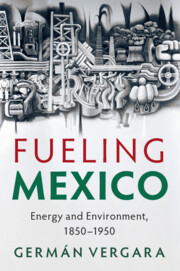Book contents
- Fueling Mexico
- Studies in Environment and History
- Fueling Mexico
- Copyright page
- Contents
- Figures and Tables
- Acknowledgments
- Introduction Energy, Environment, and History
- Chapter 1 1850s: Solar Society
- Chapter 2 The Nature of Capitalist Growth
- Chapter 3 Searching for Rocks
- Chapter 4 The Other Revolution
- Chapter 5 1950s: Fossil-Fueled Society
- Conclusion
- Bibliography
- Index
Chapter 2 - The Nature of Capitalist Growth
Published online by Cambridge University Press: 11 June 2021
- Fueling Mexico
- Studies in Environment and History
- Fueling Mexico
- Copyright page
- Contents
- Figures and Tables
- Acknowledgments
- Introduction Energy, Environment, and History
- Chapter 1 1850s: Solar Society
- Chapter 2 The Nature of Capitalist Growth
- Chapter 3 Searching for Rocks
- Chapter 4 The Other Revolution
- Chapter 5 1950s: Fossil-Fueled Society
- Conclusion
- Bibliography
- Index
Summary
Chapter 2 tracks the early stages of what I call embedded industrialization based on waterpower and increased use of biomass. After mid-century, an increasing number of industries and regions of the country mechanized manufacturing and mining with wood-burning steam engines in addition to waterpower. The state-promoted construction of a vast railroad network in the 1880s further accelerated industrialization. By the late 1880s, embedded industrialization and long-established activities, particularly silver mining, began approaching ecological limits to growth. The most easily accessible forests dwindled at alarming rates and no more rivers could be harnessed for waterpower. Embedded industrialization also faced social constraints: peasant communities clashed with factories and railroads over water and wood. The increased strain on non-fossil energy sources motivated Mexico’s state and economic elites to search for new ways to power industry. Due to its prestige and connection to European and US industrialization, coal became the favored alternative.
Keywords
- Type
- Chapter
- Information
- Fueling MexicoEnergy and Environment, 1850–1950, pp. 60 - 93Publisher: Cambridge University PressPrint publication year: 2021

